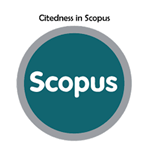Antibacterial Activity of Clove Flower (Eugenia aromatica) Extract Against Escherichia coli Clinical Isolates
Abstract
Keywords
Full Text:
PDFReferences
S. Waraningsih, W. Do Toka, M. Dahlan, and I. Rachman, “Identification of Gram Negative Bacteria in the Urine of Catheterized Patients at Referral Hospital in Ternate,” J. Kedokteran Brawijaya, vol. 33, no. 2, pp. 98–104, 2024, [Online]. Available: https://doi.org/10.21776/ub.jkb.2024.033.02.5
I. W. Rahman, N. Arfani, and J. V. Tadoda, “Detection of MRSA Bacteria (Methicillin-Resistant Staphylococcus aureus) in Inpatient Blood Samples,” J. Ilmu Alam dan Lingkungan, vol. 14, no. 1, pp. 48–54, 2023, [Online]. Available: https://journal.unhas.ac.id/index.php/jai2/article/view/26212
D. L. Walid, A. S. Nur Afiah, and I. Rahman, “Identification of Escherichia coli in Food from Restaurants around Campus II of Khairun University,” Kieraha Med. J., vol. 3, no. 1, pp. 57–65, 2021, [Online]. Available: https://doi.org/10.33387/kmj.v3i1.3271
E. R. Ekawati, S. N. Husnul Yusmiati, and F. R. Hamidi, “Detection of Pathogenic Escherichia coli in Food Using Conventional and Multiplex PCR Methods,” J. SainHealth, vol. 1, no. 2, pp. 75–82, 2017, [Online]. Available: https://doi.org/10.51804/jsh.v1i2.107
E. D. Intaningtyas, Fatimah, and Y. D. Safitri, “Clove Flower and Leaf (Syzygium aromaticum) Extract on the Growth of Escherichia coli ATCC 25922,” Higea Pharm. J., vol. 15, no. 1, pp. 71–76, 2023, [Online]. Available: http://dx.doi.org/10.52689/higea.v15i1.473
A. Pradana, D. Santosa, and T. N. S. Sulaiman, “The Potential of Clove (Syzygium aromaticum) in Indonesia as an Antibacterial and Antifungal Agent,” Pharmaceutica Magazine, vol. 20, no. 1, pp. 70–78, 2023, [Online]. Available: http://dx.doi.org/10.22146/farmaseutik.v20i1.86004
I. Tivani, W. Amananti, and A. R. Putri, “Antibacterial Activity of Turi Leaf (Sesbania grandiflora L.) Extract Handwash Against Staphylococcus aureus,” J. Ilmiah Manuntung, vol. 7, no. 1, pp. 86–91, 2021, [Online]. Available: https://doi.org/10.51352/jim.v7i1.426
S. A. Rizki, M. Latief, Fitrianingsih, and H. Rahman, “Antibacterial Activity of N-Hexane, Ethyl Acetate, and Ethanol Extracts of Durian (Durio zibethinus Linn.) Leaves Against Propionibacterium acnes and Staphylococcus epidermidis,” Jamhesic, vol. 10, no. 3, pp. 442–457, 2021, [Online]. Available: https://online-journal.unja.ac.id/kedokteran/article/view/14668
A. Paliling, J. Posangi, and P. S. Anindita, “Inhibitory Effect of Clove Flower (Syzygium aromaticum) Extract Against Porphyromonas gingivalis,” e-GIGI, vol. 4, no. 2, 2016, [Online]. Available: https://doi.org/10.35790/eg.4.2.2016.14159
Y. D. Safitri and N. E. D. Purnamawati, “Comparison of Antibacterial Activity of Methanol Extracts of Clove Stems and Flowers (Syzygium aromaticum) Against Staphylococcus aureus ATCC 25923,” J. Health and Science, vol. 3, no. 3, pp. 410–416, 2021, [Online]. Available: https://doi.org/10.25026/jsk.v3i3.354
H. A. Simanjuntak et al., “Inhibition Zone Diameter of Amoxicillin and Tetracycline Against Escherichia coli,” Herbal Med. J., vol. 5, no. 2, pp. 55–59, 2022, [Online]. Available: https://doi.org/10.58996/hmj.v5i2.52
K. B. Ugha, D. I. Rini, and S. M. J. Koamesah, “Antibacterial Activity of Ethanolic Clove (Syzygium aromaticum) Leaf Extract Against Escherichia coli In Vitro,” Cendana Med. J., vol. 7, no. 2, pp. 149–157, 2019, [Online]. Available: https://doi.org/10.35508/cmj.v7i2.1779
M. Tuntun, “Effectiveness of Papaya Leaf (Carica papaya L.) Extract on the Growth of Escherichia coli and Staphylococcus aureus,” J. Kesehatan, vol. 7, no. 3, p. 497, 2016, [Online]. Available: https://doi.org/10.26630/jk.v7i3.235
W. Lianah, N. Ayuwardani, and Y. Hariningsih, “Antibacterial Activity of Ethanol Extract of Celery (Apium graveolens L) Against Actinomyces sp. and Lactobacillus acidophilus,” Duta Pharma J., vol. 1, no. 1, pp. 32–39, 2021, [Online]. Available: https://doi.org/10.47701/dpj.v1i1.1190
R. T. Utami, S. Dewi, and S. Darmawati, “Antibacterial Activity of Clove Stem Extract Against Methicillin-Resistant Staphylococcus aureus (MRSA),” Proc. Semnas Unimus, vol. 2, pp. 116–120, 2019, [Online]. Available: https://prosiding.unimus.ac.id/index.php/psn12012010/article/view/538
M. J. Kalalo et al., “Antimicrobial Potential of Clove: A Literature Review,” Pharm. Med. J., vol. 3, no. 2, p. 53, 2020, [Online]. Available: https://doi.org/10.35799/pmj.3.2.2020.32882
N. B. Reppi, C. Mambo, and J. Wuisan, “Antibacterial Effect of Cinnamon Bark (Cinnamomum burmannii) Extract on Escherichia coli and Streptococcus pyogenes,” J. e-Biomedik, vol. 4, no. 1, 2016, [Online]. Available: https://doi.org/10.35790/ebm.4.1.2016.12204
DOI: https://doi.org/10.37311/ijpe.v5i2.30940
Refbacks
- There are currently no refbacks.
Copyright (c) 2025 Muhammad Subhan A. Sibadu, Muliani Laher, Ismail Rahman

Indonesian Journal of Pharmaceutical Education is licensed under a Creative Commons Attribution-NonCommercial-ShareAlike 4.0 International License.




